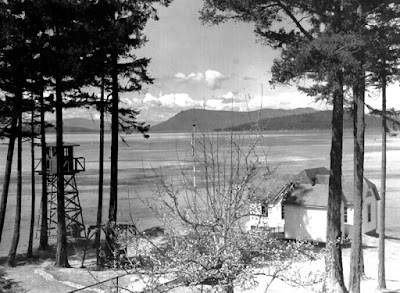We’ve visited New Dungeness Lighthouse in a previous post, but it’s such a unique spot, it’s worth looking at from multiple angles. My bucket list goal for this blog is to find a historical photo taken from the top of the lighthouse that looks out toward the end of Dungeness Spit. The reason? Due to the erosion of nearby bluffs and the currents in the Strait of Juan de Fuca that carry the eroded material to the east, Dungeness Spit lengthens by around 15 feet per year. When built in 1857, the lighthouse was only 900 feet from the end of the spit. It’s now more than a half mile from the end. I hope to someday find a historical photo that will allow us to document that growth.
In the meantime, our now and then photos show some of the changes that occurred at the lighthouse itself, which has also evolved significantly over time.
 |
| Then: 1896, courtesy National Archives / Now: Feb. 2021 |
Yes, those photos are of the same lighthouse. The tower was lowered in 1927 due to deterioration of the brickwork. So the dark section above is now gone. Many other buildings have been added and subtracted since our Then photo was taken in 1896. Most notably, the keeper’s home was added in 1904 (on the right in the Now photo).
My now photo is from a perspective a little lower in the
water then the then photo because I was shooting while sitting on my
paddleboard and I presume the historical photo was taken from a boat with a
much higher deck.
Seeing the outer fence in the historical photo reminded me of my favorite New Dungeness
Lighthouse story. It’s from a book written by James C. Isom, published by the
New Dungeness Light Station Association, and aptly titled, History of the New
Dungeness Lighthouse. The book tells us that keeper E.A. Brooks (1902-1925) kept
cows and sheep on the spit, and apparently the cows weren’t too happy with the
location:
“Several keepers likely had cows on the spit, particularly if there were small children…The Brooks family had a cow that would sometimes swim to the mainland in search of better grass. The boys would have to find the cow and drag it home for milking.”
If I was paddling out to the lighthouse and passed a cow headed for the mainland, I think I might have to give up paddling. 😊
Sources:
https://www.sequimgazette.com/news/mother-nature-and-the-dungeness-spit/
https://newdungenesslighthouse.com/the-lighthouse/
https://catalog.archives.gov/id/45708329?&sp=%7B%22q%22%3A%22dungeness%22%7D&sr=1















